How to Substitute Yarn for a Crochet Pattern
We have all done it: Chosen a pattern, absolutely fallen in love with the images the designer has listed, purchased the pattern and got to work with a yarn already shoved in our stash. The pattern said “Medium (4) weight” and off we go with any medium (4) weight. So why does the project look so much different than the designers? I’m here to tell you: It’s NOT because they’re an infinitely better crocheter or because you’ve made massive mistakes, it’s because of the yarn. So today I am happy to share my tips on how to substitute yarn in four steps so that you can have the best project outcome possible.
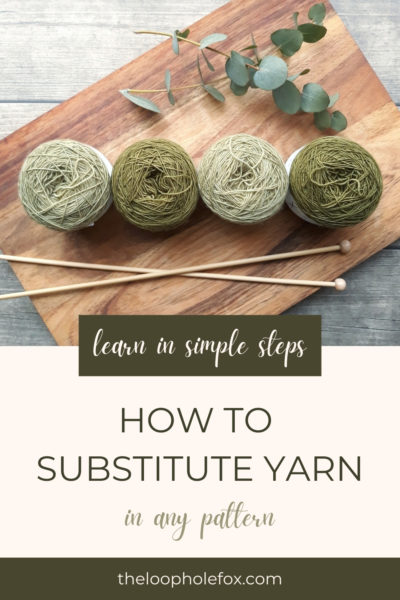
One of the questions I get asked the most is what yarn substitute a crocheter can use for my patterns. It’s a great question and one that I will definitely be keeping in mind as I continue designing. If you’ve been crocheting for any length of time, you’ve learned that not all yarns are the same even if they’re in the same weight category. So, while you may want to substitute yarn for any variety of reasons (better colors, a feel that you like better, the yarn is unavailable/discontinued, too expensive or too cheap, etc.), it’s not always as easy as just picking a yarn in another weight.
As crochet designers, we do a lot of work before we even start writing the pattern – We think about what yarn looks best for our ideal outcome, what stitches we want to use, and on and on before we get to even sitting down and working on and writing the pattern. So the final product you see is the ideal product and, sometimes using a different yarn will make your product look wildly different.
So, if you’re looking to learn how to substitute yarn to have the best possible outcome, let’s get started!
How to Substitute Yarn for a Crochet Project
Here are the things I do when I look for substitute yarns. These may not be every tip available and some of these may seem a little too math-y but, this is what I do and how I find the best yarn substitutes for my customers. I will also include a “when all else fails” option at the bottom.
1) Verify Yarn Weight
So, of course, the first thing we will want to do is verify yarn weight. Double check your chosen pattern to ensure that we are looking in the same weight category as the designer used. Verifying the yarn weight is especially important if you’re creating garments that need to fit correctly. This seems like a no brainer but there is a little more to it.
Have you ever picked up two yarns of different brands, both listed as a “medium (4)” weight and noticed that they’re surprisingly different? Why is that?
Well, each yarn is spun differently and that difference in how the yarn is actually produced creates either a thicker or thinner strand. They are both still technically in the same category, but if you’ve ever tried to work up two different brands of yarn in the same weight, you’ve likely noticed that one part of your project is smaller than the other part. That’s why. So, what to do?
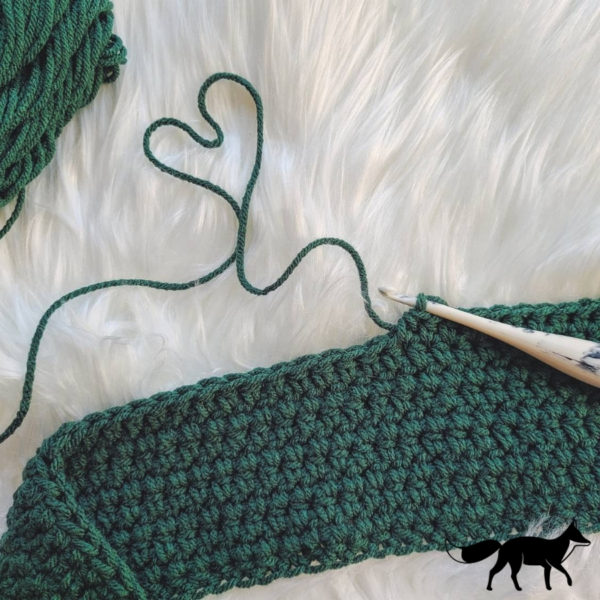
Here is where we get a bit more technical!
Check the WPI. Simply put, WPI = wraps per inch. But what does it mean?
Per this handy guide from the Craft Yarn Counsel, it’s simply a method of determining the weight of yarn by wrapping the yarn around a pencil and then using a ruler to count how many times the yarn wrapped around the pencil per inch. This is the most common method of figuring out a yarn’s weight if you’ve lost the skein label – a great trick! So, for example, a medium (4) yarn should have approximately 9-12 wraps per inch. That 9-12 wraps per inch could cause a big difference when you’re working up a project!
But how does this have anything to do with learning how to substitute yarn?
Well, according to Ravelry’s yarn weight charts, there is an “Aran” weight and a “Worsted” weight yarn, both of which are medium (4). Some people use this interchangeably, some don’t. Whether or not the yarn weight is Aran or Worsted is often not on the label, either.
If you look at the linked chart, you’ll notice that the Aran weight has 8 WPI whereas Worsted has 9 WPI. While it’s only one number off, it could make a huge difference in the fit of your project. Interestingly enough, the medium (4) weight category is the only category that has two levels listed.
So, based on the WPI, an Aran weight is slightly thicker than the Worsted weight and therefore could skew your entire project – which is especially important for garments. Scarves, blankets and such don’t matter quite as much if the size is a little different, but this could skew an entire sweater size. Check to see if the designer listed their medium (4) weight yarn as either Worsted or Aran. If they didn’t, we will need to do a little more research.
You can always google “is YARN BRAND Worsted or Aran” which should give you some clues, or you can use Ravelry’s yarn database. This database is super helpful for finding all kinds of information including: WPI, Worsted or Aran, yards/meters or ounces/grams in a typical skein, fibers used, whether or not it is machine washable, how other crocheters and knitters rate it, and more.
This is the first place I would look for the most information you can find on nearly every yarn you can think of.
1.1) Check the Yards (or Meters) per Skein
This section also pertains to the yarn weight but I feel deserves it’s own section. If all else fails, check the yards (meters) per ounce (grams) in the skein of the designers yarn and the yarn you’d like to use.
As we talked about in section 1, yarn brands vary based on how they spin their yarn, fiber content, etc. So, to get the most accurate weight, you’ll want to look for a substitute that has a similar amount of yarn in the skein. So, when you look at the yarn skein (in the US), you’ll see how much yarn is in the skein in ounces and in yards. You’ll want to divide the yards by the ounces to find out approximately how many yards are in each ounce of the strand.
If the yarn you’ve chosen has approximately the same yards per ounce ratio as the yarn the designer used, you’re in luck! This yarn should work up approximately the same as the one the designer used. This isn’t an exact science as there are still some variants to consider, but it’s as close as we can get.
A little tip: When you’re substituting yarn, purchase an extra skein just in case. It’s always better to have more yarn than you need, and if you end up with extra yarn, you can always use it on some Scrap Yarn Projects like my Little Crochet Pumpkin to use it up.
2) Check the Fiber
One of the biggest things I’ve learned for how to substitute yarn is to look at the fiber content of the yarn the designer chose before purchasing your substitute. If the yarn the designer chose is, for an easy comparison, cotton and yours is a wool blend, the overall look of the finished product is going to look, feel and drape much different.
One thing to note before we dive deep into fiber: If you are allergic to, don’t like, or don’t want to use a certain fiber for whatever reason, don’t kick yourself for using a different fiber. Your project might look a little different, but all crochet projects are beautiful regardless.
I had this question come up on my Something New Baby Blanket. I did write in that pattern that you can use any medium (4) weight yarn you prefer and the baby blanket crocheted with any yarn will be just as beautiful. However, I received a message late one night that said (I’m paraphrasing), “I want my blanket to look just like yours, but Baby Bee Stork Struck isn’t available in my country. Can you help me find a yarn substitute?”
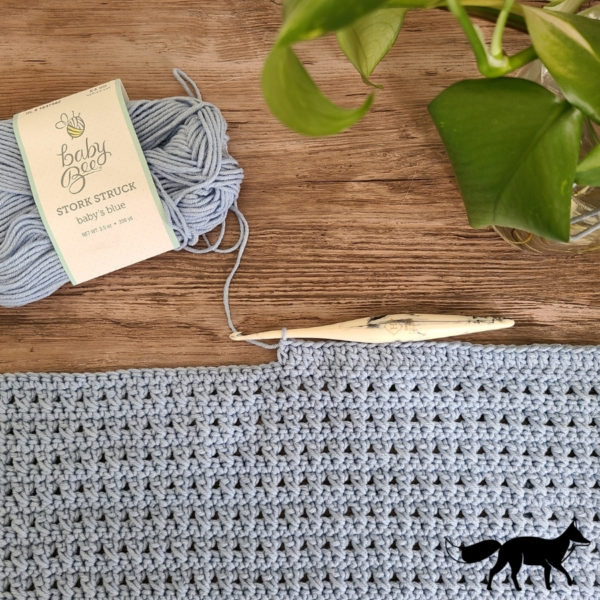
And, of course, I was happy to! So, I went off searching for a yarn substitute that would be available in this specific country and the first thing I did was look at what fiber the yarn I used was made of.
When you’re looking to create the product and have it look as similar as possible to the designers finished pattern, you’ll want your fiber to match as closely with the yarn the designer used for the same look and feel. If a designer crocheted a sweater with a gorgeous natural blend such as wool or alpaca and I used cotton, the look and feel of the sweater will be different.
Not only will your finished product look and feel different if you use a different fiber, but it could also effect how sturdy it is, how it washes (or if it can be washed), how it drapes, etc.
So, whenever possible, you want to choose a yarn that is made of the same materials as the yarn the designer used.
You might run into a situation like I had with the crocheter and my Something New baby blanket. It could have been difficult to find a yarn substitute for Baby Bee Stork Struck as it’s fiber is 50% tencel and it truly was a struggle to find another 50% tencel yarn that was also available in their country. I was able to google “50% tencel yarn” and came up with a ton of yarn brands available in the US, but not their country.
In this case, I am glad the customer reached out to me to ask for a recommendation. I already knew the feel of the yarn I used, so I was able to quickly ask “Do you have Caron Cotton Cakes available in your country?”
Luckily, they did! And we were able to get an accurate yarn substitution for this crocheter.
When in doubt, ask the designer. They may not know but the worst you can hear is “I’m not sure”. Often, though, they’ll have worked with the yarn enough that they’ll be able to help you find a substitute.
3) Check Your Gauge Before You Start
So, you’ve done your best to choose the best yarn substitute for the pattern and you’re ready to get started! But wait!
Check your gauge. I know! I can hear the groans already. I, myself, am not even a fan of doing a gauge swatch (but I still do it!).
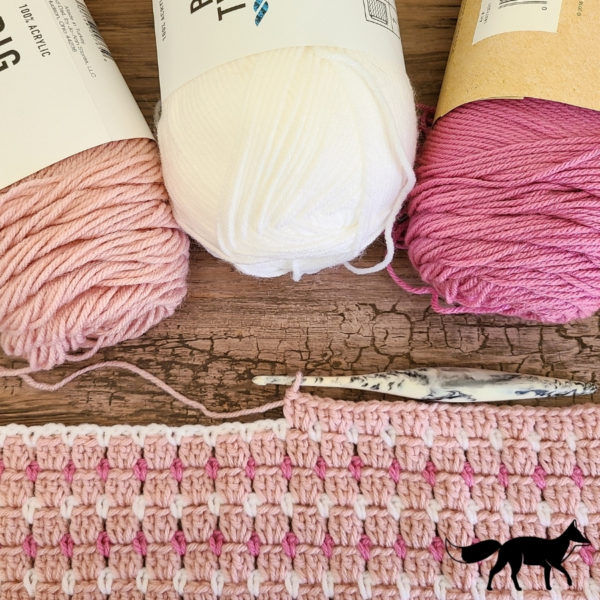
Nearly every crochet pattern should have a gauge listed, especially for wearable items like sweaters or tops. Work up a quick gauge swatch to make sure you can match the designers gauge. Because we all have different tension when crocheting, you might have to go up or down a hook size if you’re a tighter or looser crocheter naturally. That’s okay!
As long as you can match the gauge with the designers with the yarn you’ve chosen, you’re good to go.
4) A Few Other Things to Consider Before You Substitute Your Yarn
There are a few other things you might want to consider before you purchase substitute yarn (or, even, purchase the same yarn as the designer). These all have to do with your goals for the pattern. When considering the list below, think about what you’re going to do with the pattern. Are you making it for yourself? Gifting it to a friend or family member? Donating it? What is it used for?
Consider:
- Can it be washed? What about dried? Is that a deal breaker for you?
- Do you like the way it feels?
- Is it priced right for you?
- Does it make you happy?
- Is it a yarn you can see yourself working with for the entire project?
- (I can’t tell you how many skeins of yarn I have abandoned because I hated the way they felt while I worked with them).
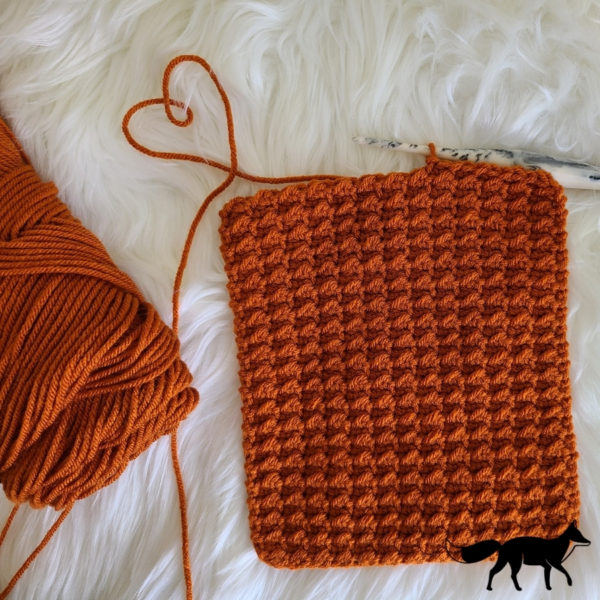
5) BONUS! When All Else Fails…
The above tips should help you figure out how to substitute yarn on your own, but if “all else fails” (or you simply want a quick place to look), check out this handy website.
Yarnsub.com is a really neat website that has a database of yarn substitutions. You can simply open the website, enter the yarn the designer used and this site will give you a list of brands you can use instead.
In the list of appropriate dupes, it will tell you how accurate the match is (for example, “Excellent” or “Good”) and break down why it is listed as either of those categories.
It will also tell you how the following categories match up to the original: cost (shown in dollar signs), texture (and ply), gauge, fiber content, the qualities of the yarn, the difference in skein size (in grams and meters) and how many skeins you would need to purchase to match the yards of the original.
This is a great website to have on your bookmarks for any crocheter, as it is a quick reference and does a great job of laying out the facts. You may still want to double check the steps above just in case, but if you need something quick, this website is the way to go.
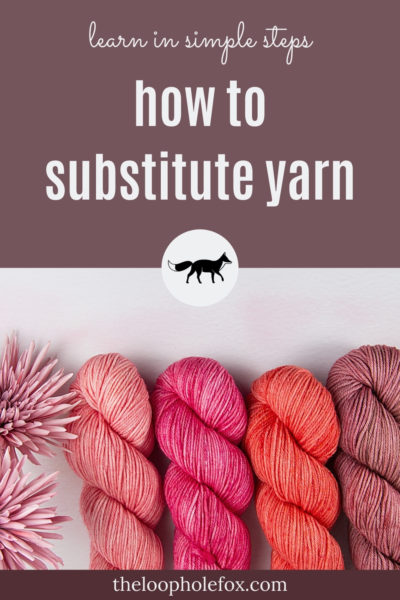
How to Substitute Yarn: Conclusion
In the end, what yarn you decide to use should always be up to you. Whether or not you’re looking for a perfect dupe for the yarn the designer used or looking to put your own spin on things, this guide should help you find an accurate yarn substitute perfect for your needs.
So, as a quick checklist, when you’re looking to substitute yarn, you should:
- Weight
- Fiber Content
- Gauge
- Your goals for the pattern
- Ask yourself if the subbed yarn brings you joy
- And finally, “if all else fails”, check Yarn Sub or Ravelry to find a quick dupe.
One thing I want to mention is that you should always do what makes you happy. If making the project exactly as the designer did makes you happy, great! But if you want to put your own spin on it by using a different yarn in the same weight category, you should! Crocheting is a hobby that should bring you joy and make you happy. If working a project with a certain yarn makes you unhappy, please remind yourself that your happiness and comfort is important.
I truly believe that there is no “bad crochet project” and that regardless of how your project turns out, it’s beautiful the way it is. Of course, if your sweater or top doesn’t fit, that might be another story, but that’s where you should be checking gauge, etc. However, just because your sweater might be a bit more fluffy where the designers was sleek, or your baby blanket might be a bit more sleek where the designers was fluffy – don’t fret. What matters most is the love you put into it and the joy you felt creating it.
Now go forth and do a crocheters favorite thing: Shop for yarn!
Don’t forget to join my Facebook Group so we can chat all about your creations! We are a group for crocheters of all experiences, all interests and love to hang out together. Come join the fun!
Shannon | Designer & Editor
Shannon helps crocheters find their next project and build their skills with in depth tutorials and crochet patterns on her blog, theloopholefox.com.
With more than a decade of crochet experience, Shannon knows that understanding why we do something matters just as much as how we do it. She teaches new techniques and crochet stitches in depth so you can crochet with confidence.
RELATED CROCHET TIPS:
How to Gingham Crochet
How to Crochet Straight Edges
How to Create the Magic Circle
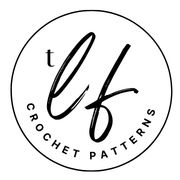

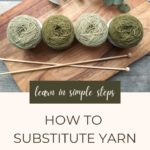
Awesome article! Clear, concise and absolutely useful, a great big YAY Shannon!
Aww thank you so much! I am so glad you found it useful!